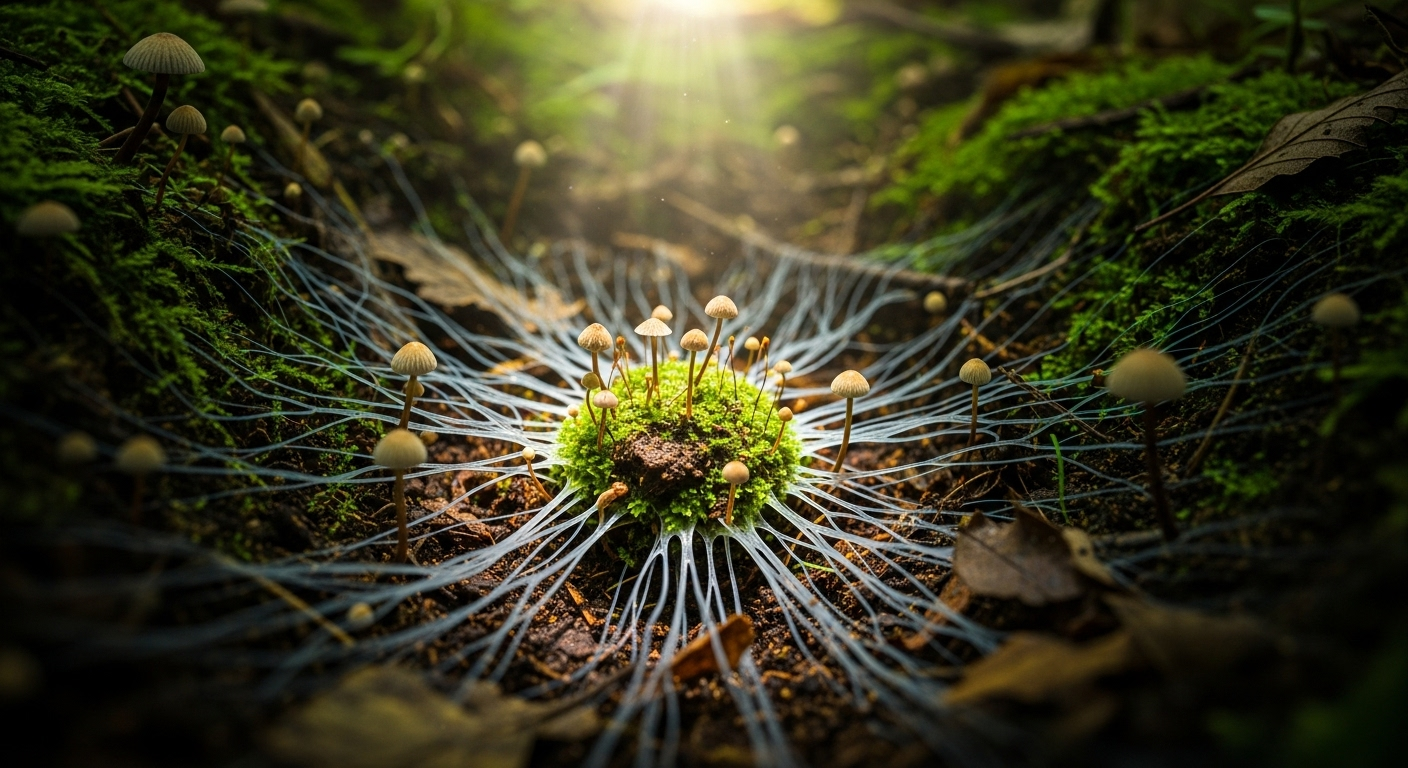Mycelial Networks: Nature's Underground Internet and Its Potential for Human Health
In a world where we're constantly seeking innovative solutions to our most pressing health challenges, nature often holds the key. Imagine a vast, intricate web of connections beneath our feet, silently orchestrating the health of entire ecosystems. What if this hidden network could revolutionize our approach to human wellness? Welcome to the fascinating world of mycelial networks, nature's own internet, and its untapped potential for transforming our health.

The concept of mycelial networks was first proposed in the late 20th century, but it wasn’t until recent years that scientists began to fully appreciate their complexity and potential. These networks play a crucial role in ecosystem health, facilitating communication between plants and enhancing their resilience to environmental stressors.
Mycelial Intelligence: Nature’s Problem-Solving Paradigm
What makes mycelial networks truly remarkable is their adaptive intelligence. These networks can solve complex problems, optimizing resource allocation and responding to environmental changes with a level of sophistication that rivals our most advanced algorithms. This natural intelligence has inspired researchers to explore how we might harness the problem-solving capabilities of mycelial networks to address human health challenges.
Scientists are now investigating how the principles of mycelial networks could be applied to everything from drug delivery systems to personalized medicine. The decentralized, adaptive nature of these networks offers a new paradigm for understanding and addressing complex health issues.
Medicinal Mushrooms: Tapping into Mycelial Wisdom
While the concept of mycelial networks is relatively new to modern science, the use of medicinal mushrooms has been a cornerstone of traditional medicine for millennia. Mushrooms like reishi, lion’s mane, and cordyceps have long been prized for their health-promoting properties. Now, with our growing understanding of mycelial networks, we’re beginning to unlock the full potential of these fungal allies.
Research has shown that many medicinal mushrooms contain bioactive compounds with powerful anti-inflammatory, immune-modulating, and neuroprotective properties. These compounds are often produced as part of the mushroom’s role in the larger mycelial network, highlighting the interconnected nature of ecosystem and human health.
Biomimicry in Healthcare: Learning from Nature’s Design
The study of mycelial networks has given rise to a new field of biomimicry in healthcare. By mimicking the structure and function of these natural networks, researchers are developing innovative approaches to drug delivery, tissue engineering, and even brain-computer interfaces.
One exciting application is in the field of regenerative medicine. Scientists are exploring how to create artificial mycelial-like networks that can guide the growth of new tissues or deliver targeted therapies to specific areas of the body. This approach could revolutionize treatments for everything from spinal cord injuries to neurodegenerative diseases.
The Gut-Mycelium Connection: A New Frontier in Microbiome Research
Perhaps one of the most intriguing areas of mycelial network research is its potential impact on our understanding of the human microbiome. Just as mycelial networks facilitate communication and resource sharing in ecosystems, our gut microbiome plays a crucial role in maintaining overall health.
Researchers are now exploring the parallels between mycelial networks and the human microbiome, investigating how the principles of fungal communication and resource allocation might be applied to promote a healthy gut ecosystem. This research could lead to novel probiotics and targeted therapies for a range of digestive and systemic health issues.
Ecological Health: Bridging the Gap Between Environmental and Human Wellness
As we delve deeper into the world of mycelial networks, it becomes increasingly clear that ecosystem health and human health are inextricably linked. The principles that govern these natural networks – resilience, adaptability, and interconnectedness – offer valuable lessons for our approach to healthcare and wellness.
By recognizing the importance of mycelial networks in maintaining ecological balance, we gain a new perspective on the importance of preserving biodiversity and protecting natural ecosystems. This holistic view of health, encompassing both environmental and human wellness, could reshape our approach to public health policy and environmental conservation.
Mycelial Marvels: Fascinating Facts and Wellness Wisdom
-
Mycelial networks can extend for miles, with the largest known organism being a honey fungus covering 2,385 acres in Oregon’s Malheur National Forest.
-
Some trees use mycelial networks to share resources with their offspring, giving seedlings a better chance of survival.
-
Certain mushrooms in mycelial networks can break down pollutants and plastics, offering potential solutions for environmental cleanup.
-
Research suggests that compounds found in lion’s mane mushroom may stimulate nerve growth factor production, potentially benefiting cognitive health.
-
Mycelial networks inspired the design of the Tokyo subway system, demonstrating the potential for biomimicry in urban planning and infrastructure.
As we continue to unravel the mysteries of mycelial networks, we open up a world of possibilities for human health and ecological wellness. By learning from nature’s ingenious designs, we can develop more holistic, interconnected approaches to healthcare that recognize the fundamental unity of all living systems. The future of wellness may well lie beneath our feet, in the wisdom of the Wood Wide Web.




